Nuclear Power Industry Celebrates Half Century
Korea wants nuclear power to take the lead in green growth and evolve into an export industry
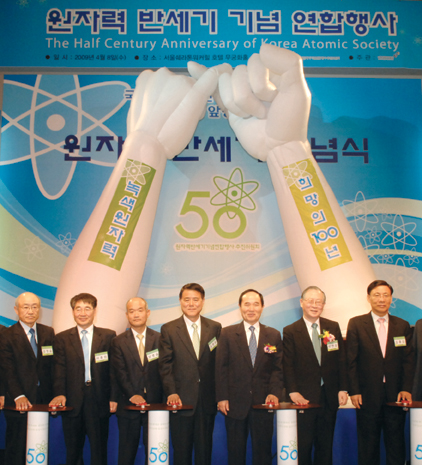 As the Korean nuclear power industry celebrates its 50th anniversary, industry, academic and research circl'ses are united to make a leap forward as a key player in the green growth paradigm.
As the Korean nuclear power industry celebrates its 50th anniversary, industry, academic and research circl'ses are united to make a leap forward as a key player in the green growth paradigm.
Approximately 400 people from government, industry, academia and research circles assembled for an official ceremony to mark the half centennial of nuclear power at the Walker Hill Hotel in Seoul on April 8. Among those present at the ceremony, organized by the Ministry of Education, Science and Technology (MEST) and the Committee for the Promotion of the Event Celebrating the 50th Anniversary of Nuclear Power, jointly headed by Lee Jong-in, president of the Korea Nuclear Society and Kim Ssang-su, concurrently chairman of the Korea Atomic Industrial Forum (KAIF) and KEPCO, were MEST Minister Ahn Byong-man; Park Chan-mo, special science and technology advisor to the President; Yang Myung-seung, president of the Korea Atomic Energy Research Institute (KAERI); Kim Jong-shin, president of Korea Hydro & Nuclear Power Co.; Shim Kyu-sang, COO of Doosan Heavy Industries and Construction; Kwon Oh-hyung, president of KPS; Lee Hun-gyu, president of KINAC; Min Gye-hong, director of the Korea Radwaste Management Corp.; William E. Burchill, president of the American Nuclear Society; and Yoshiaki Oka, chairman of the Japanese Atomic Energy Society.
President Lee Myung-bak, in a message to the attendees at the event, stressed the significance of nuclear power in order to promote green growth and realize energy security on the occasion of the 50th anniversary of nuclear power. Presidential Science and Technology Special Advisor Park read the message on behalf of President Lee.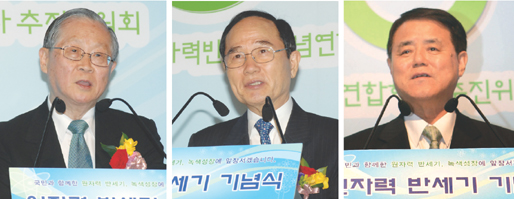
Lee said, "Nuclear power can be credited with the stabilization of the supply of cheap electricity to people as well as companies in Korea least bestowed with energy resources, and as the world has to address two tasks, securing a stable supply of energy and simultaneously reducing greenhouse gasses emissions, nuclear power is taking the lead in helping the nation pursue green growth and realize energy self-sufficiency." MEST Minister Ahn said, "Nuclear power should be fostered as the nation's representative export industry by aggressively exploring the growing overseas nuclear reactor construction market." He noted that Korea wants to bid for the new Dutch research reactor, the PALLAS project, and work on the development of the system-integrated modular advanced reactor (SMART) and pyro-processing for spent nuclear fuel on its own.
True to the theme, "Let nuclear power, alongside the people for a half century, take the lead in green growth," the participants adopted a written five-point pledge to do their utmost to make nuclear power a force behind green growth. The resolution calls for enhancing the sustainability of nuclear power by securing public confidence; realizing low-carbon, green growth; reinvigorating the national economy by fulfilling the goal to export nuclear power abroad and bracing for the arrival of the era of the "hydrogen economy" through the development of futuristic nuclear systems and improving the public welfare and quality of life through the use of radioisotopes.
The ceremony was an opportunity for the participants to renew their pledge to make nuclear power a force behind the government's green growth initiatives by expanding the role of nuclear power and concentrating their capabilities on exporting nuclear power. The Korean government wants to expand nuclear power's portion of the nation's total power generation from 36 percent in 2007 to 59 percent in 2030 by making the most of the unprecedented growth of the Korean nuclear power industry in the past half century.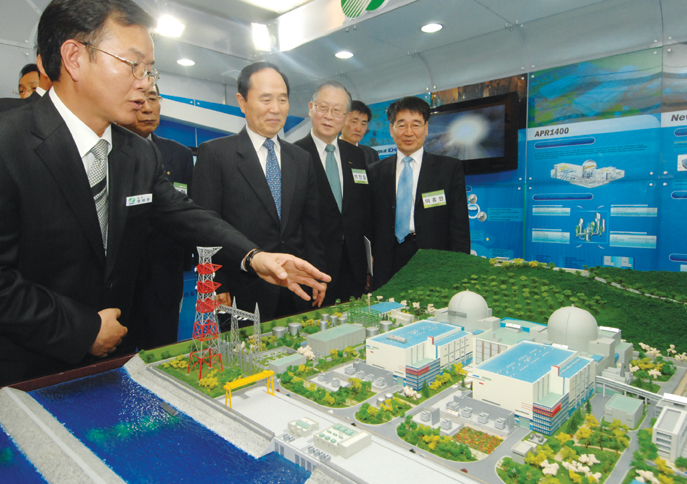
The ceremony was followed by the "Green Walkathon Together with Nuclear Power," an event designed to publicize the 'green energy -- nuclear power vision.' Those in the nuclear power industry as well as the general public walked 7 km along the Namsan Circular Road.
The year 2009 marks half of a century since nuclear power came into existence. Korea has so far grown into a nuclear powerhouse, ranking sixth in the world in terms of nuclear power generation. Nuclear power has served as a major force behind the stabilization of prices and the nation's economic growth.
The Korean nuclear power industry has made strides toward exporting nuclear power technology through such achievements as the development of the Korea Standard Nuclear Power Plant, the localization of nuclear fuel and its own design for the high-flux advanced neutron application reactor (HANARO).
It was in 1958 that the Nuclear Power Agency, predecessor of the MEST, was established to build an administrative system for nuclear power. The Korea Atomic Energy Research Institute and the Nuclear Power Manpower Development Department at Seoul National University were inaugurated to build the infrastructure for nuclear power in 1959. In 1978, the Kori Nuclear Power Unit 1 began commercial operation, making Korea the second nuclear powerhouse in Asia following Japan.
The domestic nuclear power industry has performed feats in almost every field of nuclear power including design, materials manufacturing, fuel supply and maintenance.
In 2008, Kori Unit 1 was allowed to stay in operation for another 10 years after its 30-year design life expired. Korea has also just begun a project to build a low- and intermediate-level radwaste treatment facility in Gyeongju City, solving a thorny issue that had been delayed by public disputes regarding the safety of the projected facility.
In a feat of the Korean nuclear power industry, Doosan Heavy Industries & Construction has recently succeeded in winning an order to supply the main units of a new-type nuclear power plant to the United States, which is the first such order placed since the States' resumption of projects to build nuclear power plants. Doosan signed a 300 million won contract with Westinghouse on May 8 to supply two reactors and four steam generators to what will be both the first new-type nuclear power unit in the United States and the first nuclear power facility to be built in that country after a 30-year hiatus. The projected power plant in Georgia will be a 1,100 MW-class AP1000, a third-generation pressured light water reactor type model developed by Westinghouse, whose safety and economic efficiency has been dramatically improved. The units will be manufactured at Doosan's plant in Changwon and delivered to the work site by March 2014.
In the latest development, KOPEC was recently awarded a Greek research reactor deal by beating out INVAP and AREVA to pave for the way for exporting a package of consulting services on the design of a research reactor abroad for the first time.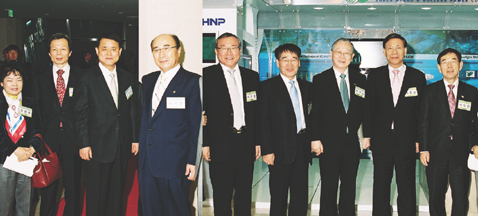
MKE Okays Execution of Shin-Ulchin Units 1&2
The Ministry of Knowledge Economy (MKE) gave the go-ahead to the execution plan on the construction of Shin-Ulchin Nuclear Power Units 1&2. The power resource development project promotion committee, headed by the vice minister of the MKE, held a meeting on March 25 to give the green light to the execution plan of the project.
The projected nuclear units will be the second to be fitted with the APR1400, following the first application of the advanced Korean-type reactor into Shin-Kori Nuclear Power Units 3&4.
The project calls for the construction of two 1,400MW-class nuclear units at a cost of 6.29 trillion won in Deokcheon-ri, Buk-myeon, Uljin-gun, North Gyeongsang Province, by 2016.
The planned Shin-Ulchin units will be built wholly with Korea's own technology. Korea has so far relied on foreign technology in some key installations as the reactor coolant pump (RCP) and the man-machine interface system (MMIS). Na Ga-yong, director in charge of the nuclear power industry at the MKE, said the government will decide on the localization of RCM and MMIS after a technology review of the installations by the end of May when a contract on key installations is to be signed. If their safety and economical features are proven, the planned Shin-Ulchin Units 1&2 will be the first to be wholly constructed with Korea's own technology, he added.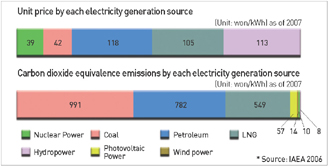
If completed as planned by 2016, the two new units will bring to 28 the number of nuclear power units in operation in Korea, accounting for a 40.1 percent share of the nation's total power generation, or 211,448 GWh, officials at the Korea Hydro & Nuclear Power Co. said. Korea's dependence on nuclear will lead to reducing greenhouse gas emissions by about 207 million tons per year compared to coal-fired plants.
Last year, Korea established the first national energy master plan calling for a rise in nuclear power's portion of total power capacity to 41 percent and constructing 12 more units by 2022 in an effort to support the low-carbon green-growth initiatives of the Lee Myung-bak government. nw
Dignitaries celebrate the 50th anniversary of the Korean nuclear power industry. (From right) KHNP President Kim Jong-shin,; Park Chan-mo, special science and technology advisor to the President,; MEST Minister Ahn Byong-man,; Kim Ssang-su, chairman of the Korea Atomic Industrial Forum and concurrently chairman of KEPCO,; KAERI President Yang Myung-seung, ; Korean Nuclear Society President Lee Jong-in,; and Kang Chang-soon, ex-KNS president.
(from left) Park Chan-mo, special science and technology advisor to the President,; MEST Minister Ahn Byong-man,; and Chairman of the Korea Atomic Industrial Forum and concurrently Chairman of KEPCO Kim Ssang-su, each deliver a message at the anniversary ceremony.
Dignitaries, including MEST Minister Ahn, take a look at one of the model nuclear power facilities on display at the KHNP Pavilion.
KINAC President Lee Hun-gyu,; Kim Ssang-su, chairman of the Korea Atomic Industrial Forum,; KNEF Chairman Lee Jae-hwan,; Korean Nuclear Society Vice President Park Kun-cheol,; KNS President Lee Jong-in,; Park Chan-mo, special science and technology advisor to the President,;KHNP President Kim Jong-shin,; KNF President Lee Ik-hwan,; and NewsWorld President-Publisher Elizabeth M. Oh pose in front of the site of a nuclear power exhibition.
3Fl, 292-47, Shindang 6-dong, Chung-gu, Seoul, Korea 100-456
Tel : 82-2-2235-6114 / Fax : 82-2-2235-0799